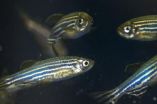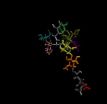(Press-News.org) PHILADELPHIA — Using a zebrafish model of a human genetic disease called neurofibromatosis (NF1), a team from the Perelman School of Medicine at the University of Pennsylvania has found that the learning and memory components of the disorder are distinct features that will likely need different treatment approaches. They published their results this month in Cell Reports.
NF1 is one of the most common inherited neurological disorders, affecting about one in 3,000 people. It is characterized by tumors, attention deficits, and learning problems. Most people with NF1 have symptoms before the age of 10. Therapies target Ras, a protein family that guides cell proliferation. The NF1 gene encodes neurofibromin, a very large protein with a small domain involved in Ras regulation.
Unexpectedly, the Penn team showed that some of the behavioral defects in mutant fish are not related to abnormal Ras, but can be corrected by drugs that affect another signaling pathway controlled by the small molecule cAMP. They used the zebrafish model of NF1 to show that memory defects – such as the recall of a learned task -- can be corrected by drugs that target Ras, while learning deficits are corrected by modulation of the cAMP pathway. Overall, the team's results have implications for potential therapies in people with NF1.
"We now know that learning and memory defects in NF1 are distinct and potentially amenable to drug therapy," says co-senior author Jon Epstein, MD, chair of the department of Cell and Developmental Biology. "Our data convincingly show that memory defects in mutant fish are due to abnormal Ras activity, but learning defects are completely unaffected by modulation of these pathways. Rather these deficits are corrected with medicines that modulate cAMP."
Over the last 20 years, zebrafish have become great models for studying development and disease. Like humans, zebrafish are vertebrates, and most of the genes required for normal embryonic development in zebrafish are also present in humans. When incorrectly regulated, these same genes often cause tumor formation and metastatic cancers.
Zebrafish have also become an ideal model for studying vertebrate neuroscience and behavior. In fact, co-senior author Michael Granato, PhD, professor of Cell and Developmental Biology, has developed the first high-throughput behavioral assays that measure learning and memory in fish. For example, Granato explains, "normal fish startle with changes in noise and light level by bending and swimming away from the annoying stimuli and do eventually habituate, that is get used to the alternations in their environment. But, NF1 fish mutants fail to habituate. However, after adding cAMP to their water, they do learn, and then behave like the non-mutant fish."
This clearly indicates that learning deficits in the NF1 mutant fish are corrected by adding various substances that boost cAMP signaling. "Our data also indicate that learning and memory defects are reversible with acute pharmacologic treatments and are therefore not hard-wired, as might be expected for a defect in the development of nerves," says Epstein. "This offers great hope for therapeutic intervention for NF1 patients."
INFORMATION:
Co-first authors Marc A. Wolman and Eric D. de Groh, Sean M. McBride, and Thomas A. Jongens, all from Penn, were also on the paper.
The work was funded by the National Heart, Lung and Blood Institute (R01 HL062974, HD 37975A11) and the National Institute of Mental Health (RO1 MH092257), the Department of Defense, the FRAXA Research Foundation, and the University of Pennsylvania Clinical Research Scholars Program.
Penn Medicine is one of the world's leading academic medical centers, dedicated to the related missions of medical education, biomedical research, and excellence in patient care. Penn Medicine consists of the Raymond and Ruth Perelman School of Medicine at the University of Pennsylvania (founded in 1765 as the nation's first medical school) and the University of Pennsylvania Health System, which together form a $4.3 billion enterprise.
The Perelman School of Medicine has been ranked among the top five medical schools in the United States for the past 17 years, according to U.S. News & World Report's survey of research-oriented medical schools. The School is consistently among the nation's top recipients of funding from the National Institutes of Health, with $392 million awarded in the 2013 fiscal year.
The University of Pennsylvania Health System's patient care facilities include: The Hospital of the University of Pennsylvania -- recognized as one of the nation's top "Honor Roll" hospitals by U.S. News & World Report; Penn Presbyterian Medical Center; Chester County Hospital; Penn Wissahickon Hospice; and Pennsylvania Hospital -- the nation's first hospital, founded in 1751. Additional affiliated inpatient care facilities and services throughout the Philadelphia region include Chestnut Hill Hospital and Good Shepherd Penn Partners, a partnership between Good Shepherd Rehabilitation Network and Penn Medicine.
Penn Medicine is committed to improving lives and health through a variety of community-based programs and activities. In fiscal year 2013, Penn Medicine provided $814 million to benefit our community.
Zebrafish model of a learning and memory disorder shows better treatment
2014-09-15
ELSE PRESS RELEASES FROM THIS DATE:
Advancing the science for health programming in crisis conditions
2014-09-15
September 12, 2014 -- Humanitarian crises are becoming increasingly complex and a growing threat to the health and safety of populations. An improved evidence-base to guide interventions in the countries most vulnerable to these conditions is more critical than ever. A paper by researchers at Columbia University's Mailman School of Public Health published online in the journal Science, looks at the challenges of doing research in such settings and the strategies that must be adopted for scientific advance.
"The circumstances of humanitarian crises present many barriers ...
Decoding 'sweet codes' that determine protein fates
2014-09-15
VIDEO:
Here are movies of dynamic behavior of a sugar chain on the basis of NMR-validated simulations. This chain has a particular sugar (green circle).
Click here for more information.
We often experience difficulties in identifying the accurate shape of dynamic and fluctuating objects. This is especially the case in the nanoscale world of biomolecules. The research group lead by Professor Koichi Kato of the Institute for Molecular Science, National Institutes of Natural Sciences ...
You don't walk alone
2014-09-15
65 million people around the world today suffer from epilepsy, a condition of the brain that may trigger an uncontrollable seizure at any time, often for no known reason. A seizure is a disruption of the electrical communication between neurons, and someone is said to have epilepsy if they experience two or more unprovoked seizures separated by at least 24 hours.
Epilepsy is the most common chronic disease in pediatric neurology, with about 0.5% of children developing epilepsy during their lifetime. A further 30% of epileptic children develop refractory ...
Walking or cycling to work improves wellbeing, University of East Anglia researchers find
2014-09-15
Walking or cycling to work is better for people's mental health than driving to work, according to new research by health economists at the University of East Anglia and the Centre for Diet and Activity Research (CEDAR).
A report published today reveals that people who stopped driving and started walking or cycling to work benefited from improved wellbeing. In particular, active commuters felt better able to concentrate and were less under strain than if they travelled by car.
These benefits come on top of the physical health benefits of walking and cycling that are ...
Nature: New drug blocks gene driving cancer growth
2014-09-15
When active, the protein called Ral can drive tumor growth and metastasis in several human cancers including pancreatic, prostate, lung, colon and bladder. Unfortunately, drugs that block its activity are not available. A study published today in the journal Nature uses a novel approach to target the activation of these Ral proteins: "When you want to keep an alligator from biting you, you can tie its mouth shut. We took another approach – we put a stick in its mouth to hold it open," says Dan Theodorescu, MD, PhD, professor of Urology and Pharmacology, director of the ...
Blood-cleansing biospleen device developed for sepsis therapy
2014-09-15
Things can go downhill fast when a patient has sepsis, a life-threatening condition in which bacteria or fungi multiply in a patient's blood -- often too fast for antibiotics to help. A new device inspired by the human spleen and developed by a team at Harvard's Wyss Institute for Biologically Inspired Engineering may radically transform the way doctors treat sepsis.
"Even with the best current treatments, sepsis patients are dying in intensive care units at least 30 percent of the time," said Mike Super, Ph.D., Senior Staff Scientist at the Wyss Institute. "We need ...
Muscular dystrophy: Repair the muscles, not the genetic defect
2014-09-15
ANN ARBOR, Mich.---A potential way to treat muscular dystrophy directly targets muscle repair instead of the underlying genetic defect that usually leads to the disease.
Muscular dystrophies are a group of muscle diseases characterized by skeletal muscle wasting and weakness. Mutations in certain proteins, most commonly the protein dystrophin, cause muscular dystrophy in humans and also in mice.
A University of Michigan team led by cell biologist Haoxing Xu, discovered that mice missing a critical calcium channel inside the cell, called TRPML1, showed similar muscle ...
Three's a charm: NIST detectors reveal entangled photon triplets
2014-09-15
BOULDER, Colo – Researchers at the University of Waterloo in Canada have directly entangled three photons in the most technologically useful state for the first time, thanks in part to superfast, super-efficient single-photon detectors developed by the National Institute of Standards and Technology (NIST).
Entanglement is a special feature of the quantum world in which certain properties of individual particles become linked such that knowledge of the quantum state of any one particle dictates that of the others. Entanglement plays a critical role in quantum information ...
The Lancet: Some lung cancer patients could live longer when treated
2014-09-15
Treating advanced small-cell lung cancer (SCLC) with thoracic (or chest) radiation therapy in addition to standard treatment significantly prolongs long-term survival and reduces cancer recurrence in the chest by almost 50%, according to new research published in The Lancet and being presented simultaneously at ASTRO's 2014 Annual Meeting in San Francisco.
The authors say that as the thoracic radiotherapy is well tolerated, it should to be routinely offered to all SCLC patients with extensive disease whose cancer responds to chemotherapy.
SCLC is an aggressive cancer ...
Researchers find neural compensation in people with Alzheimer's-related protein
2014-09-15
Berkeley — The human brain is capable of a neural workaround that compensates for the buildup of beta-amyloid, a destructive protein associated with Alzheimer's disease, according to a new study led by researchers at the University of California, Berkeley.
The findings, to be published Sunday, Sept. 14, in the journal Nature Neuroscience, could help explain how some older adults with beta-amyloid deposits in their brain retain normal cognitive function while others develop dementia.
"This study provides evidence that there is plasticity or compensation ability in ...






